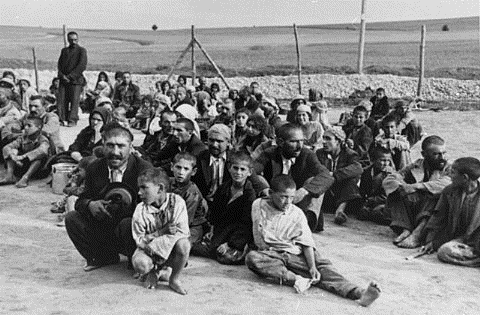

A group of Romani prisoners, awaiting instructions from their German captors, sit in an open area near the fence in the Belzec concentration camp.
Photo credit: Archives of Mechanical Documentation, courtesy of USHMM Photo Archives


A group of Romani prisoners, awaiting instructions from their German captors, sit in an open area near the fence in the Belzec concentration camp.
Photo credit: Archives of Mechanical Documentation, courtesy of USHMM Photo Archives
Romani (commonly but incorrectly called Gypsies) were considered by the Nazis to be social outcasts. Under the Weimar Republic--the German government from 1918 to 1933--anti-Romani laws became widespread. These laws required them to register with officials, prohibited them from traveling freely, and sent them to forced-labor camps. When the Nazis came to power, those laws remained in effect--and were expanded. Under the July 1933 sterilization law, many Romani were sterilized against their will.In November 1933, the "Law Against Dangerous Habitual Criminals" was passed. Under this law, the police began arresting Romani along with others labeled "asocial." Beggars, vagrants, the homeless, and alcoholics were arrested and sent to concentration camps.
The Nuremberg racial laws of September 15, 1935, did not specifically mention Romani, but they were included along with Jews and "Negroes" as "racially distinctive" minorities with "alien blood." As such, their marriage to "Aryans" was prohibited. They were also deprived of their civil rights.
By the summer of 1938, large numbers of German and Austrian Romani were rounded up and sent to concentration camps. There they wore black triangular patches (the symbol for "asocials") or green patches (the symbol for professional criminals) and sometimes the letter "Z."
As was the case for the Jews, the outbreak of war in September 1939 radicalized the Nazi regime's policies towards the Romani. Their "resettlement to the East" and their mass murder closely parallel the systematic deportations and killings of the Jews. It is difficult to determine exactly how many Romani were murdered. The estimates range from 220,000 to 500,000.
Source: Dr. William L. Shulman, A State of Terror: Germany 1933-1939. Bayside, New York: Holocaust Resource Center and Archives.
Sinti and Roma: Victims of the Nazi Era provides additional information about this victim group, including an historical background and information on Robert Ritter, a Nazi racial scientist.
Bibliography of sources related to the Sinti and Roma in the Holocaust.
Extensive article about the fate of the Romani peoples in Germany and German-occupied countries.
An article about genocide of the Roma in the Holocaust.
A history of Roma persecution in Europe from 1589 to the present by Harold Tanner.
An article about the Romani victims of Nazi terror by Myriam Novitch.
Photographs of Roma during the Third Reich.
A short history of the Roma and their fate under the Third Reich from the Mining Company.
News release by Richard Murphy about the commemoration of Romani victims at Buchenwald.
Information on the evolution of Nazi policy toward the Roma by Ben Austin.
More information on the treatment and murder of the Roma.
Notes on the Nazi extermination of the Roma.
Notes on the legal status of the Roma in the Third Reich.
Sinti and Roma bibliography from the United States Holocaust Memorial Museum.
| Victims | Perpetrators | Bystanders | Resisters | Rescuers | Liberators | Survivors | Children |
A Teacher's Guide to the Holocaust
Produced by the Florida Center for Instructional Technology,
College of Education, University of South Florida © 1997-2013.